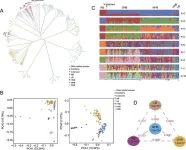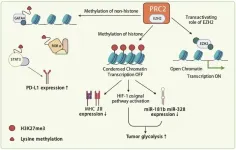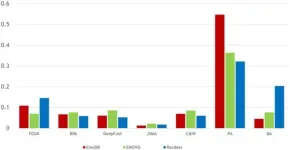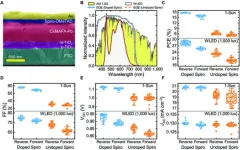(Press-News.org) The general health of forests can be estimated by the micro- and macronutrient content of tree leaves to help inform forest management decisions in the light of climate change, species loss and other variables. Traditional methods of assessing nutrient levels in forests are expensive and labor-intensive. Researchers recently analyzed the reflected spectra from tree foliage to accurately estimate the nutrients of leaves, offering a faster, larger-scale method of assessing forest health.
Field methods of collecting leaf samples and then measuring foliage nutrient content in the lab are time-consuming. New, faster methods are required to estimate forest health as climate change alters growing conditions. To address this issue, a team of researchers from the University of Massachusetts and the University of Virginia analyzed reflected light (spectra) across a wide range of wavelengths from forest foliage to accurately determine the concentrations of calcium (Ca), magnesium (Mg), potassium (K), phosphorus (P), manganese (Mn), and zinc (Zn) in leaves.
The team published the study on June 27 in the Journal of Remote Sensing.
Specifically, the researchers measured reflected light at wavelengths from 400 to 2,450 nanometers (nm, 1.0 x 10-9 m) to assess nutrient concentrations. The team was able to identify the best wavelengths to measure each nutrient analyzed through a partial least squares regression (PLSR). PLSR is especially well-suited to manage highly correlated independent variables, like the individual reflectence over a continuous spectrum.
“The developed PLSR model predicted plant nutrients with moderate to strong accuracy for macro- and micronutrients in temperate hardwood forests of the Northeastern United States. Spectral measurements combined with wavelength selection and PLSR models can be used to quantify foliar macro- and micronutrients at regional scales and can be further improved by incorporating site geologic materials and tree genera,” said Qian Yu, associate professor in Earth, Geographic, and Climate Sciences at the University of Massachusetts-Amherst and the corresponding author of the research paper.
The researchers realized that their ability to accurately use spectra to determine the nutrient level of tree foliage could be significantly improved by considering the soil type in which the trees grew in. Notably, this variable is often overlooked when assessing the nutrient composition of tree leaves. The team measured the foliage nutrients Ca and P of trees in four types of soil: coarse glacial till, glaciofluvial, melt-out till and outwash. By accounting for soil type, researchers improved their PLSR nutrient analysis accuracy from R2 = 0.66 to R2 = 0.87 (an R2, or coefficient of determination, that equals 1.0 indicates that all variation observed is due to differences in the independent variable, or spectral measurements).
Different soils had greater and lesser effects on Ca and P. Soil had little effect on Ca concentrations, for example, but tended to affect P to a greater degree. Outwash soil also provided the most accurate predictions for both Ca and P nutrients. Critically, Ca is a limiting nutrient in forests that plays important roles in plant structure, chemical signaling and as an enzyme cofactor that changes enzyme efficiency.
The genus of the trees additionally affected the accuracy of foliage nutrient concentration predictions. In fact, analyzing spectral data based on tree genera improved the accuracy of nutrient predictions even better than soil composition. Tree genus improved Ca prediction accuracy from R2 = 0.66 to as high as R2 = 0.91 and R2 = 0.93 for Fagus (Beech) and Quercus (Oak) genera, respectively. The team analyzed spectral data for Acer (Maple) and Betula (Birch) genera as well.
The research team suggests that specific tree genera likely influence foliage nutrients because the physiological mechanisms responsible for nutrient acquisition and transport are genetically controlled and unique to each genus. Additionally, some tree genera may require individual nutrients more than other genera that may be more adapted to a particular soil, resulting in differences in nutrient uptake.
Ultimately, the research team is hopeful that their new spectral assessment technique will be successfully applied to other hardwood forests to inform important forest management decisions. “The method introduced in this paper holds promise for large-scale plant nutrient assessment and can decrease the costs of traditional, field-based approaches,” said Wenxiu Teng, Ph.D. candidate in Earth, Geographic, and Climate Sciences at the University of Massachusetts-Amherst and first author of the paper.
Other contributors to this research include Justin B. Richardson and Alexandrea M. Rice from the Department of Environmental Sciences at the University of Virginia in Charlottesville and Ivan C. Mischenko from the Department of Earth, Geographic, and Climate Sciences at the University of Massachusetts in Amherst and.
This research was supported by the University of Massachusetts Amherst, College of Natural Sciences by Award 1801.
END
Spectral measurements capable of estimating nutrient content of forest tree leaves
2024-08-09
ELSE PRESS RELEASES FROM THIS DATE:
Blueprint for blueberry improvement: genetic and epigenetic discoveries
2024-08-09
Recent research has uncovered significant genetic and epigenetic variations in blueberry cultivars, particularly between northern highbush (NHB) and southern highbush (SHB) blueberries. The study highlights gene introgression's role in SHB's adaptation to subtropical climates and identifies key genes, such as VcTBL44, associated with fruit firmness. These findings offer valuable insights and resources for future blueberry breeding.
Blueberries, part of the Vaccinium genus, are renowned for their nutritional benefits and increasing global demand. However, cultivation faces challenges like ...
The heightened importance of EZH2 in cancer immunotherapy
2024-08-09
Enhancer of zeste homolog 2 (EZH2) is a catalytic subunit of the Polycomb-repressive complex 2 (PRC2), which plays a crucial role in transcriptional repression through the methylation of histone H3 on lysine 27 (H3K27me3). This epigenetic modification leads to chromatin compaction and gene silencing. EZH2 is frequently overexpressed in a variety of cancers, including head and neck, breast, prostate, bladder, colorectal, lung, pancreatic, melanoma, and lymphoma. Mutations in the EZH2 gene are also prevalent in several hematological malignancies, such as B-lymphomas and follicular lymphomas. The dual role of EZH2 as both a tumor suppressor and oncogene depending on the cancer type ...
Researchers expose vulnerability of speech emotion recognition models to adversarial attacks
2024-08-09
Recent advancements in speech emotion recognition have highlighted the significant potential of deep learning technologies across various applications. However, these deep learning models are susceptible to adversarial attacks. A team of researchers at the University of Milan systematically evaluated the impact of white-box and black-box attacks on different languages and genders within speech emotion recognition. The research was published May 27 in Intelligent Computing, a Science Partner Journal.
The ...
Classical music lifts our mood by synchronizing our “extended amygdala”
2024-08-09
Whether Bach, Beethoven, or Mozart, it’s widely recognized that classical music can affect a person’s mood. In a study published August 9 in the Cell Press journal Cell Reports, scientists in China use brainwave measurements and neural imaging techniques to show how Western classical music elicits its positive effects on the brain. Their goal is to find more effective ways to use music to activate the brain in those who otherwise don’t respond, such as people with treatment-resistant depression.
“Our research integrates the fields of neuroscience, psychiatry, and ...
New technology uses light to engrave erasable 3D images
2024-08-09
Imagine if physicians could capture three-dimensional projections of medical scans, suspending them inside an acrylic cube to create a hand-held reproduction of a patient's heart, brain, kidneys, or other organs. Then, when the visit is done, a quick blast of heat erases the projection and the cube is ready for the next scan.
A new report in the journal Chem by researchers at Dartmouth and Southern Methodist University (SMU) outlines a technical breakthrough that could enable such scenarios, and others with widespread utility.
The study introduces a technique that uses a specialized ...
How did mental health parity laws affect new moms?
2024-08-09
Pregnant and postpartum women with depression and anxiety have a slightly better chance of getting psychotherapy these days, a new study finds. And they are paying less of their own money when they do.
The changes in care and cost happened mainly after the Affordable Care Act took effect in 2014, and to a lesser extent after the Mental Health Parity and Addiction Equity Act, or MHPAEA, took effect in 2010, the analysis shows.
Both laws aimed at reducing insurance-related barriers to mental health care.
Even so, only about 10% of women with private insurance ...
Universal free school meals and school and student outcomes
2024-08-09
About The Study: In this systematic review, universal free school meals were associated with increased meal participation, no or slight improvements in attendance, and decreased obesity prevalence and suspension rates; certainty of evidence was moderate for lunch participation and low or very low for other outcomes. Studies did not report several important outcomes, such as diet quality and food security, suggesting the need for more high-quality research encompassing policy-relevant indicators.
Corresponding Author: To ...
Researchers crack a key celiac mystery
2024-08-09
People with celiac disease must navigate everyday life by avoiding gluten, a protein in wheat, rye and barley which can trigger painful symptoms in the gut, impede the absorption of nutrients and raise the risk of other serious long-term issues.
The autoimmune disorder affects about 1 per cent of the population. Its rate of occurrence has roughly doubled in the past 25 years, but there is no treatment available.
An interdisciplinary team of medical and engineering researchers centred at Canada’s McMaster University and including colleagues from the US, Australia, and Argentina, has spent the ...
Continuing climate warming trend and pronounced interannual variability in precipitation in the Three Gorges Region in 2022–2023
2024-08-09
The Three Gorges Region of the Yangtze River (TGR) in China has a unique geographical location, complex geomorphological features, and a fragile and sensitive climate. The Three Gorges Project, as a large-scale comprehensive water conservancy hub project in the region, has not only greatly changed the nature, society and economy of the area, but also brought great benefits and created problems, such as environmental and climatic impacts. Therefore, it is of great importance to conduct climate and environmental monitoring in the region.
Recently, a team led by Chen Xianyan, a Professor at ...
Is doping of Spiro-OMeTAD a requirement for efficient and stable perovskite indoor photovoltaics?
2024-08-09
In this work, we study the outdoor and indoor photovoltaic performance of LHP-based devices utilizing Spiro-OMeTAD as the hole-transport material with commonly used dopants such as lithium bis(trifluoromethanesulfonyl)imide (Li-TFSI) or without any dopants. We find out that, despite the expected low performance of devices employing undoped Spiro-OMeTAD layer under 1-Sun illumination (up to 7.7% efficiency), the devices achieve up to 25.6% efficiency under 1000 lux illumination, which is comparable to the doped counterpart devices achieving up to 29.7% efficiency. This is mainly due to the major improvement in fill factor when going towards low-light ...







